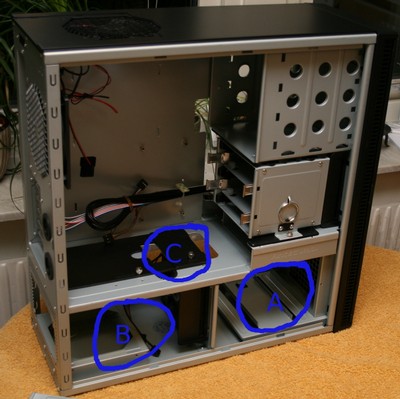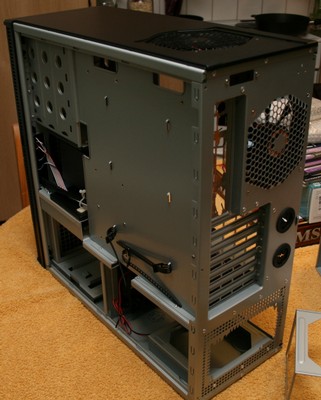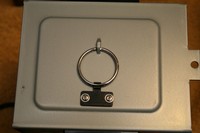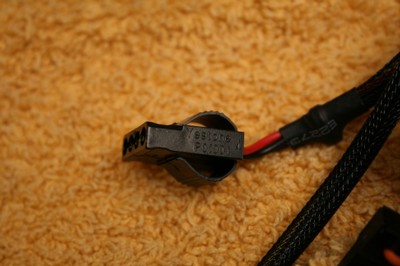Review: Antec P182 with Seasonic S12
A while ago, I decided to buy a new computer. I had three main requirements:\
- It had to be faster than my previous computer. As the old one was more than three years old, this requirement would not be hard to fulfil :-).
- It had to be quiet. Very important!
- It had to be reasonably power efficient. I try to keep my energy consumption down. \
I’ve tested various ways of getting a quiet computer over the years, the most famous one being the beautiful red box described here. This time, I did however go for a more standard solution that involved less red paint..
Hardware
After some research on quiet computer cases and power supplies, I ordered the following stuff.\
Case
Antec P182 \
Power supply \
Seasonic S12-II, 380W \
Motherboard\
MSI K9AG Neo2 Digital\
Disks\
2x SAMSUNG HD321KJ in a Software RAID1 configuration\
CPU\
AMD Athlon X2 BE-2400 45W BOXED\
Memory\
2x 1GB DDR2 800MHz\
\
The Antec P182
The first thing I noticed about this case when I collected it at the post office was that it is very heavy. Another thing I noticed when taking it out of its cardboard box was that when you knock on one of the sides of it, there’s much less sound than when knocking on the side of a standard case. This comes from the fact that the sides are covered in plastic instead of being just steel, and I think it contributes much to keeping the computer quiet, as vibrations are less likely to travel through the sides of the case. \
Opening up the case

What is very interesting is that Antec has chosen to divide the flow of air into two distinct flow paths. There is the lower airpath where air flows from the front, through an air filter that can be easily removed for cleaning, then through the lower drive bay, via a 12cm fan that can be individually controlled via a speed controller attached to a small cable, and then finally through the power supply.
Then there’s the upper airpath where air flows from the front, through a second washable air filter, into the upper part of the box exiting through one of two 12cm individually controllable 12cm fans. The two top fans are controlled by external fan switches at the back of the case, which allows adjustments of speed without opening the case. For my configuration, I run the back fan at its lowest speed. I have not connected the top fan at all.
Separating the air that flows through the power supply from the air in the rest of the box ensures that the power supply’s fan doesn’t have to run at top speed to move air that is hot because the processor or graphics card is producing heat. This is a problem seen in many other cases - even when there’s a quiet 12cm fan in the case that can move the hot air out of the box, the power supply fan runs at high speed because its heat sensor feels the hot air that passes through the PSU and acts accordingly, causing unnecessary noise. With the P182’s solution, this doesn’t happen - the power supply’s heat sensor only detects the heat generated by the harddrives and the power supply itself.
The area marked with C is a special plastic slider that ensures that as little air as possible travels between the upper and the lower air paths, while still allowing cables to be run from the power supply up to the motherboard and other parts requiring power, and also down to the lower drive bay to power the hard drives.
The right side of the case

Attention to detail

Conclusion
Overall, I’m extremely happy with this case. It’s high quality, and it’s very very quiet! If you’re willing to pay for quality, I definitely recommend this case.\
Seasonic S12-II
The Antec P182 is sold without power supply unit (PSU). That gives the
owner flexibility in finding a PSU that fits with the requirements.

Like the Antec P182, the S12 has an aura of quality. It has a nice black
finish, and the outgoing cables are neatly organized.
The PSU claims that it is very power efficient, which means that a lot
of the energy going into the PSU actually comes out. This is not the
case with cheap PSU’s, where a lot of energy is wasted in the conversion
from high voltage AC to 12 and 5V DC. The energy wasted generates heat,
which has to be ventilated. So, an efficient PSU not only saves your
electric bill, it also makes your computer more quiet!
Here’s a really nice feature - the 12V standard connectors for
connecting for example old harddrives, DVD readers, etc, are of a
special make that are much easier to disconnect.
Conclusion
Seasonic S12-II is a PSU I can recommend.
